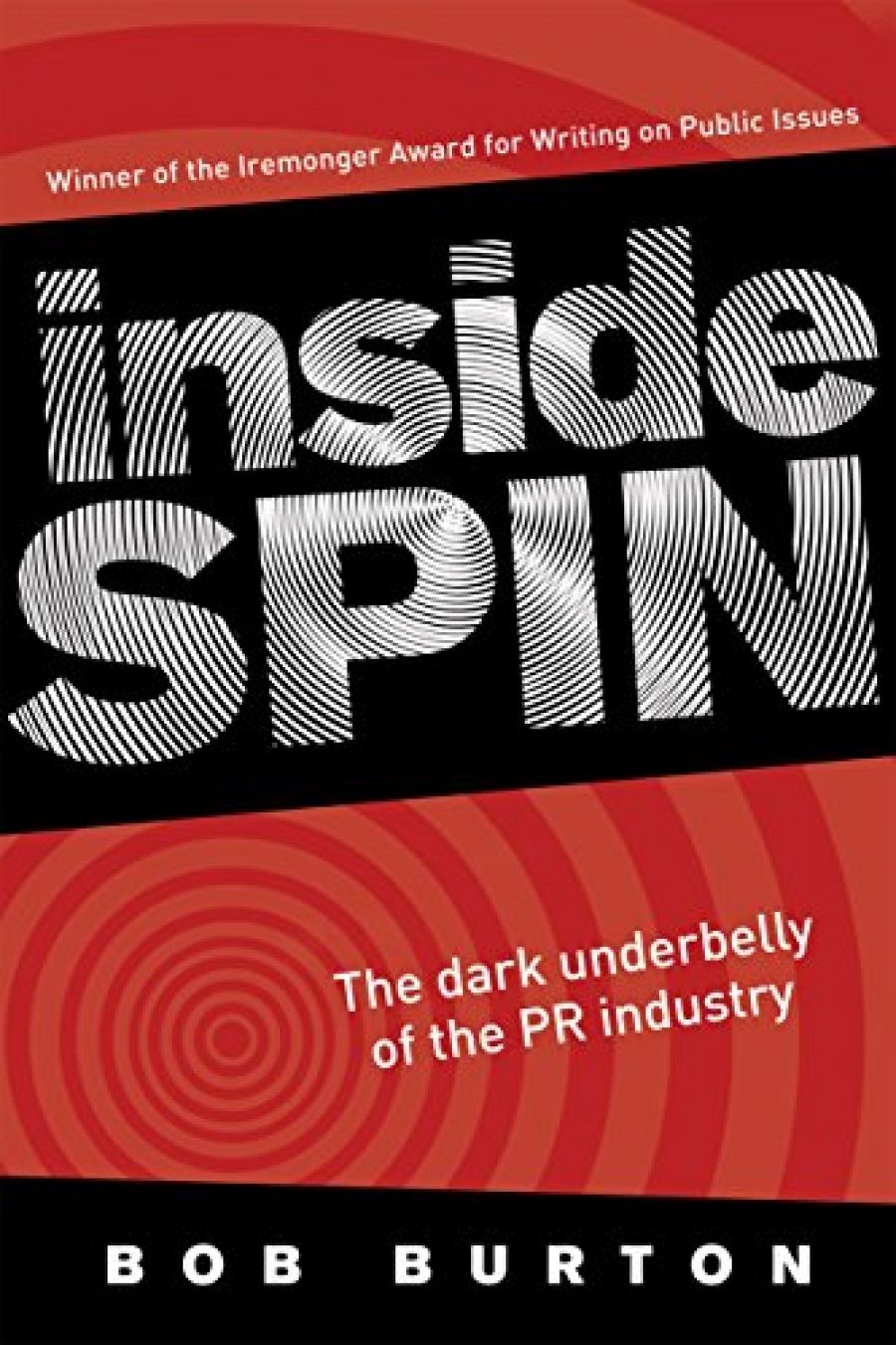
- Free Article: No
- Contents Category: Media
- Review Article: Yes
- Article Title: Focus on the Dummy
- Online Only: No
- Custom Highlight Text:
Bob Burton is not one to pull punches: early in Inside Spin he describes the public relations (PR) industry as one dominated by a ‘culture of secrecy’ with its practitioners operating ‘on the basis that they are most successful when they are nowhere to be seen’. That the industry is largely unregulated adds to the sense of unease that many Australians feel about its activities.
- Book 1 Title: Inside Spin
- Book 1 Subtitle: The Dark underbelly of the the PR industry
- Book 1 Biblio: Allen & Unwin, $24.95 pb, 313 pp
- Book 1 Cover Small (400 x 600):

- Book 1 Cover (800 x 1200):

Less obvious has been the government’s willingness to support commercial programming that promotes its messages. In this regard, the author cites the Seven Network’s successful series Border Security, which was facilitated by extensive access to the facilities and staff of the Australian Customs Service, the Australian Quarantine Service and the Department of Immigration and Multicultural Affairs. Such access had been authorised by the highest levels of government. According to Burton, the deciding factor in Seven’s successful bid to produce the series was its willingness to grant to the Commonwealth agencies involved a veto over what was broadcast. Not surprisingly, the series presented a predominantly uncritical and positive account of Australia’s border security and immigration detention measures. It is difficult to refute the author’s contention that the series provided ‘a potent communications weapon with which to shape public debate on immigration and refugee policy’. As Burton points out, viewers of the series saw no interviews with traumatised detainees of immigration centres nor those wrongly deported from the country.
Another unsettling development identified by the author has been the creation by large corporations of sham ‘grass roots campaigns’ (or ‘Astroturf’ campaigns), with the purpose of stifling competition. One of the most egregious instances occurred in 1998 with the creation of a ‘community action group’ in opposition to a proposed shopping centre in Sydney’s west. Among the activities of the group was the distribution of a brochure expressing concern about the impact of the development, including drug dealing in the area. Legal proceedings later revealed that the action group had been the concoction of a PR agent acting under the instructions of a multinational shopping centre manager that wished to prevent the development to avoid competition with one of its nearby shopping complexes.
Some companies have resorted to promoting ‘corporate social responsibility’ practices as a means of deflecting public disquiet about their activities. The theory seems to be that by promoting accountability and transparency and addressing the needs of ‘stakeholders’, a company will be better able to avoid criticism. Among the companies to have embraced social responsibility promotions are the tobacco companies. While Inside Spin makes it clear that the author has researched extensively to uncover the insincerity of these initiatives, Burton leaves it to the reader to grasp the inherent contradiction – not to say absurdity – of a tobacco company presenting itself as a socially responsible institution.
A more sophisticated approach has been the tactic of funding think-tanks to push a company’s interests. As Burton puts it, a tobacco company seeking to influence government policy would be unlikely to attract a sympathetic audience speaking for itself; however, ‘a little funding routed via a think-tank enables the policy agenda of corporate donors to be projected to a broader audience with more credibility’. While commonly perceived as being independent bodies, the majority of think-tanks are anything but neutral, as the author makes clear. Nor are journalists necessarily wise to the loyalties of the think-tanks; far from exercising proper scrutiny over their activities, the author contends that journalists tend to ‘focus on the dummy and ignore the ventriloquist’. Think-tanks rely heavily on corporate sponsorships, the details of which are not publicly disclosed. While resisting compulsory disclosure of their own funding arrangements, think-tanks and other political lobbyists continue to demand that donations made to non-government organisations opposed to business groups (such as The Wilderness Society) be open to public scrutiny.
Nor do these tactics exhaust the options available to an organisation intent on spinning its message; others include having practising journalists vet PR campaigns and press releases; sponsoring activities apparently unconnected to the company’s business activities (in order to ‘rub shoulders’ with influential policy makers); and ‘managing’ the contents of potentially damaging statements by exploiting close relationships with senior public servants. As the author points out in the book’s conclusion, the PR industry has become huge and ubiquitous, so much so that Inside Spin can serve only as an introduction to the industry’s practices in Australia. To this extent, however, it succeeds well.
For an otherwise quality publication, there were too many errors to ignore: the two worst examples were the name of an Australian PR executive spelled two different ways in the one paragraph (on page 5), and the description of an American sportswear company said to have been ‘widely dammed’ for exploiting cheap labour (on page 83). Such howlers take the gloss off good writing. Publishers should increase their budgets for editing and proofreading. To end on a positive note, the book has a good index.


Comments powered by CComment